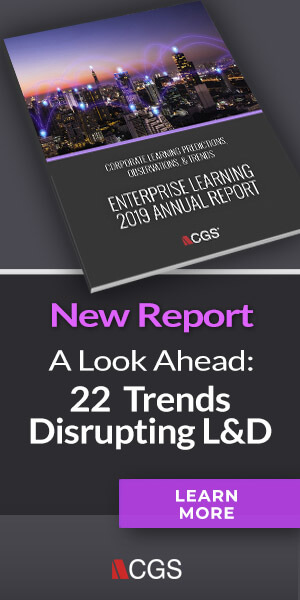Topics
Addressing Goals through Learning - at the Speed of Your Business

Let’s face it. As much as we’ve come to quantify, qualify, track, and improve our time management skills, there’s still an ongoing shortage of time – for work, play, sleep, or any combination of the three. Especially for Learning and Development (L&D). If you’re in the L&D field, you may be no stranger to the “Learning promotes loyalty” headline. L&D leaders are always looking for ways to seamlessly blend learning into career development. For readers who prefer proof through numbers, Glassdoor states that 65% of Millennials consider culture over salary, and The Ladders echoes this trend: 61% of employees prioritize career growth over pay.
Let’s briefly discuss two major real-time learning topics and trends, both of which could have huge implications for your organization.
Learning how to learn as a baseline for personalization
First, can you easily answer the following: Do you know and/or understand your teams’ learning styles well enough to maximize learning absorption, engagement, and developmental ROI?
To any leader’s credit, the aforementioned question above is, in fact, a loaded one, for two big reasons. It’s foremost tough to pinpoint personalization preferences given that business goals, needs, and associated learning topics or milestones are just as much in flux as the technologies, vendors, thought leaders, topics, and mediums through which they are delivered. In other words- it’s hard to keep up with all the variabilities for how and when to deliver learning. Secondly, it can be a naturally difficult task for people to self-select preferences without the right vocabulary for what to call said preferences for their learning wants and needs, or even their overall learning style.
To put this into context, let’s imagine a scenario. You’re a leader who just came back from a hot-ticket learning conference and started a free trial for audio learning that you learned about at the conference. You are sure that this new “snackable” micro-learning you are sending out to your team members via podcast-style audio lessons, will ensure they can multitask learning while working, lunching, driving or otherwise, and is less “heavy” feeling than traditional learning channels. If you haven’t surveyed learning styles and channel personalization, you may get everything from cheers and compliments, to “I prefer silence to concentrate at my desk – and more specifically on my ride home to decompress so I have no use for your learning mixtape!”
The recommendation? Start by dialoguing with your teams around creating their own “operating manual” which should cover how they prefer feedback, praise, delivery and learning style. Then, use an off-site or team meetings to have everyone share their operating manual with examples of specific successes to help foster collaboration as a group and find team preferences as a cohort. If the vocabulary for knowing one’s self isn’t readily available to then fold into a learning style, use a simple tool (many can be found online, such as the Myers–Briggs Type Indicator) to take a free personality assessment. You can also boost and scale this effort through technology and data analysis using polls, social channels, chatbots, interactive surveys and the results already logged in your LMS. More on this below! Knowing how your team members and you are cognitively wired, can be a tremendous way to get honest and efficient answers and squash previously held assumptions.
Lean into digital learning circles – right from your laptop or mobile phone
The ever-evolving phenomenon of social networking and subsequently, social learning, means that the opportunities to collaborate, ideate, and teach each other, are riper than ever. And the speed of such experiences through digital internal communications apps such as Slack (think: slack channel learning discussions on topics like #emergingleaders where employees can send articles, create threads on topics they are trying to solve, etc.) are making things even faster and easier if not more fun and uplifting (who doesn’t love the occasional learning meme of gif?).

This trend also has important implications for globalizing learning and the true diversity of thought in what we may call “learning without boundaries,” by allowing for international or interdepartmental collaboration within one’s own organization as well as within learning circles built for global practitioners across multiple enterprises. These avenues may further foster micro-mentoring or what is called “accountability partners” whereupon “pen pals” keep up through a chat portal and encourage progress, share resources, tips, best practices, etc. in a more one-on-one fashion.
With these apps and trends pushing faster connectivity, the ingestion, absorption, but then shift back to other priorities that are not formally “learning and development,” should speed up as well. This is akin to what HR thought leader Josh Bersin calls Learning in the Flow of Work: “We don’t want people to be ‘addicted’ to the learning platform, we want them to learn something, apply it, and then go back to work.”
Measuring success- does it actually prove beneficial?
At the end of the day, there are multiple creative ways to ramp-up your personalized, native, and collaborative learning strategies alongside the speed of fluid business needs and goals. How do you track an employee’s progress through the learning journey in real-time?
Measuring any combination of these outlets requires a macro or micro approach. For a larger-scale and lagging indication, use quarterly, bi-annual, or annual employee listening/engagement surveys with a few questions on learning, learning resources, and developmental growth.
If your business needs change frequently throughout the year – perhaps based on seasonality and drastic changes in demand – consider leveraging employee feedback as a way to adjust your learning. Encourage an L&D feedback forum on a more frequent basis. For a more consistent lightweight approach, simply encourage people leaders to incorporate a learning question in one-on-ones or in team meetings, with the simple topic of “what did you learn this week?”
No matter how you approach measurement, keep your measurements relevant to LOB (line of business) leaders and the data-points important to the C-Suite’s KPIs. All leaders should be analyzing how learning and the engagement with learning (or because of it as a byproduct), affect the following; retention, NPS (net promoter score- how customers perceive the downstream effects of said learning upskilling or tweaks as an experience with the product and/or service), or even engagement via ENPS (employee net promoter score). ENPS helps act as a lagging indicator to the future quality of hire within organizations where word-of-mouth referrals act as a healthy source. This is due to the x-factor effect of productive and engaged employees referring other like-minded candidates in hopes for a successful hire. For more insights on measuring success, see CGS’s “Metrics Series.”
What is one of the best and easiest ways to encourage a lifelong learning mindset or a #learningeverywhere culture? Don’t restrict these answers to simply work-related or professional answers. Constantly talk about learning via facts, skills, hobbies, trades etc. and your team will inevitably want to play “show and tell!” Keep the momentum of learning going through this type of #learningeverwhere culture so that the team can always adjust to your business goals in real-time.

